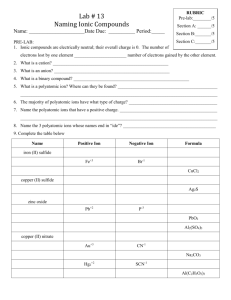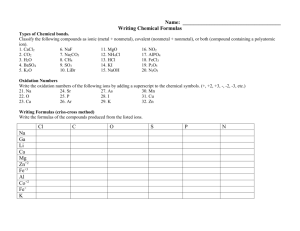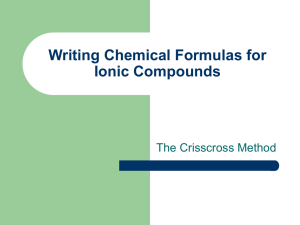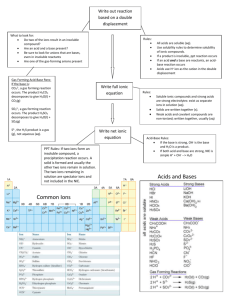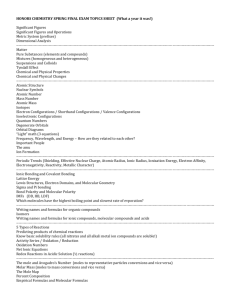Chapter 6 - An Introduction to Chemistry
advertisement
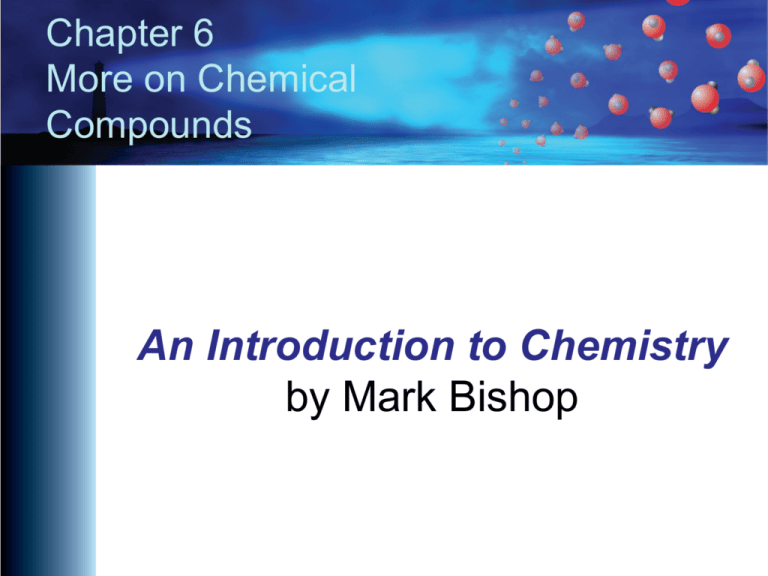
Chapter 6 More on Chemical Compounds An Introduction to Chemistry by Mark Bishop Chapter Map Monatomic Ion Names • Monatomic Cations – (name of metal) • Groups 1, 2, and 3 metals • Al3+, Zn2+, Cd2+, Ag+ – (name of metal)(Roman numeral) • All metallic cations not mentioned above • Monatomic Anions – (root of nonmetal name)ide Roots of Nonmetals H hydrC carbN nitrP phosphO oxS sulfSe selen- F fluorCl chlorBr bromI iod- Monatomic Anions H− hydride nitride N3− phosphide P3− oxide O2− sulfide S2− selenide Se2− fluoride F− chloride Cl− bromide Br− iodide I− Polyatomic Ions Ion Name Ion Name NH4+ ammonium NO3− nitrate OH− hydroxide SO42− sulfate CO32− carbonate C2H3O2− acetate PO43− phosphate Polyatomic Ions with Hydrogen • • • • • HCO3− HSO4− HS− HPO42− H2PO4− hydrogen carbonate hydrogen sulfate hydrogen sulfide hydrogen phosphate dihydrogen phosphate Recognizing Ionic Compounds • Metal-nonmetal…binary ionic compound • Metal-polyatomic ion • Ammonium-nonmetal or ammonium polyatomic ion Converting Ionic Formulas to Names • Name – (name of cation) (name of anion) Cation Names Metals with one possible charge (Al, Zn, Cd, and Groups 1, 2, 3) name of metal Metals with more than one possible charge (the rest) name(Roman numeral) polyatomic cations (e.g. ammonium) name of polyatomic ion Anion Names monatomic anion (root of nonmetal name)ide polyatomic anion name of polyatomic ion Converting Ionic Names to Formulas • Determine the formula, including charge, for the cation and anion. • Determine the ratio of the ions that yields zero overall charge. Monatomic Ions Binary Covalent Common Names – H2O, water – NH3, ammonia – CH4, methane – C2H6, ethane – C3H8, propane Naming Binary Covalent Compounds • If the subscript for the first element is greater than one, indicate the subscript with a prefix. – We do not write mono- on the first name. – Leave the "a" off the end of the prefixes that end in "a" and the “o” off of mono- if they are placed in front of an element that begins with a vowel (oxygen or iodine). • Follow the prefix with the name of the first element in the formula. Naming Binary Covalent Compounds • Write a prefix to indicate the subscript for the second element. • Write the root of the name of the second symbol in the formula. • Add -ide to the end of the name. Prefixes mon(o) di tri tetr(a) pent(a) hex(a) hept(a) oct(a) non(a) dec(a) Roots of Nonmetals H hydrC carbN nitrP phosphO oxS sulfSe selen- F fluorCl chlorBr bromI iod- Forms of Binary Covalent Names • prefix(name of nonmetal) prefix(root of name of nonmetal)ide (for example, dinitrogen pentoxide) • or (name of nonmetal) prefix(root of name of nonmetal)ide (for example, carbon dioxide) • or (name of nonmetal) (root of nonmetal)ide (for example, hydrogen fluoride) Writing Binary Covalent Formulas • Write the symbols for the elements in the order mentioned in the name. • Write subscripts indicated by the prefixes. If the first part of the name has no prefix, assume it is mono-. Arrhenius Acid Definition • An acid is a substance that generates hydronium ions, H3O+ (often described as H+), when added to water. • An acidic solution is a solution with a significant concentration of H3O+ ions. Characteristics of Acids • Acids have a sour taste. • Acids turn litmus from blue to red. • Acids react with bases. Strong Acid and Water When HCl dissolves in water, hydronium ions, H3O+, and chloride ions, Cl−, ions form. Solution of a Strong Acid Types of Acids • Binary acids have the general formula of HX(aq) – HF(aq), HCl(aq), HBr(aq), and HI(aq) • Oxyacids have the general formula HaXbOc. – HNO3 and H2SO4 • Organic (carbon-based) acids – HC2H3O2 Acetic Acid Monoprotic and Polyprotic Acids • If each molecule of an acid can donate one hydrogen ion, the acid is called a monoprotic acid. • If each molecule can donate two or more hydrogen ions, the acid is a polyprotic acid. • A diprotic acid, such as sulfuric acid, H2SO4, has two acidic hydrogen atoms. • Some acids, such as phosphoric acid, H3PO4, are triprotic acids. Strong and Weak Acids • Strong Acid = due to a completion reaction with water, generates close to one H3O+ for each acid molecule added to water. • Weak Acid = due to a reversible reaction with water, generates significantly less than one H3O+ for each molecule of acid added to water. http://preparatorychemistry.com/acids_flash.htm Weak Acid and Water Acetic acid reacts with water in a reversible reaction, which forms hydronium and acetate ions. Solution of Weak Acid Strong and Weak Acids Sulfuric Acid H2SO4(aq) + H2O(l) H3O+(aq) + HSO4(aq) HSO4(aq) + H2O(l) ⇌ H3O+(aq) + SO42(aq) Acid Summary Binary acid Strong hydrochloric acid, HCl(aq) Weak Hydrofluoric acid Oxyacid nitric acid, HNO3 other acids with sulfuric acid, HaXbOc H2SO4 Organic acid none acetic acid, HC2H3O2 Names and Formulas of Binary Acids • Names have the general form of hydro(root)ic acid, such as hydrochloric acid. • The formulas are usually followed by (aq), such as HCl(aq). Names and Formulas for Oxyacids • If enough H+ ions are added to a (root)ate polyatomic ion to completely neutralize its charge, the (root)ic acid is formed. – Nitrate, NO3−, goes to nitric acid, HNO3. – Sulfate, SO42−, goes to sulfuric acid, H2SO4. (Note the -ur- in the name.) – Phosphate, PO43−, goes to phosphoric acid, H3PO4. (Note the -or- in the name.) Chemical Nomenclature • General procedure for naming compounds (See Table 5.5 in the text.) – Step 1: Decide what type of compound the name or formula represents. – Step 2: Apply the rules for writing the name or formula for that type of compound. Goal: To develop conversion factors that will convert between a measurable property (mass) and number of particles Measurable Property 1 Number of Particles 1 Number of Particles 2 Measurable Property 2 Mass 1 Moles 1 Moles 2 Mass 2 Molecular Mass • Whole = sum of parts • mass of a molecule = sum of the masses of the atoms in the molecule • molecular mass = the sum of the atomic masses of the atoms in the molecule Molar Mass For Molecular Compounds • Molecular Mass = Sum of the atomic masses of atoms in one molecule ⎛ (molecular mass) g molecular compound ⎞ ⎜ ⎟ 1 mol molecular compound ⎝ ⎠ Formula Units • A formula unit of a substance is the group represented by the substance’s chemical formula, that is, a group containing the kinds and numbers of atoms or ions listed in the chemical formula. • Formula unit is a general term that can be used in reference to elements, molecular compounds, or ionic compounds. Formula Unit Examples Formula Mass for Ionic Compounds • Whole = sum of parts • Mass of a formula unit = sum of the masses of the atoms in the formula unit • Formula mass = the sum of the atomic masses of the atoms in the formula Molar Mass For Ionic Compounds • Formula Mass = Sum of the atomic masses of the atoms in a formula unit ⎛ (formula mass) g ionic compound ⎞ ⎜ ⎟ 1mol ionic compound ⎝ ⎠ Molar Mass Development General Conversions Units of One Substance to Units of Another Study Sheets • Write a description of the “tip-off” that helps you to recognize the type of problem the calculation represents. • Write a description of the general procedure involved in the particular type of problem. • Write an example of the type of calculation. Sample Study Sheet: Converting Between Mass of Element and Mass of Compound Containing the Element • Tip-off: When you analyze the type of unit you have and the type of unit you want, you recognize that you are converting between a unit associated with an element and a unit associated with a compound containing that element. Sample Study Sheet (2) • General Steps – Convert the given unit to moles of the first substance. – Convert moles of the first substance to moles of the second substance using the molar ratio derived from the formula for the compound. – Convert moles of the second substance to the desired units of the second substance. Units of Element to Units of Compound Calculating Empirical Formulas Step 1: If you are not given mass in grams for each element, convert the data you are given to grams of each element. • This may involve simple unit conversions. For example, you may be given pounds or milligrams, which you convert to grams using dimensional analysis. • Sometimes you are given the percentage of each element in the compound. Assume that you have 100 g of compound, and change the units of the values given for the percentages to grams. Calculating Empirical Formulas Step 2: Convert grams of each element to moles by dividing by the atomic mass of the element. Step 3: Divide each mole value by the smallest and round your answers to whole numbers or common mixed fractions. Step 4: If you have a fraction after the last step, multiply all the mole values by the denominator of the fraction. Step 5: The resulting mole values correspond to the subscripts in the empirical formula. Calculating Empirical Formulas Calculating Molecular Formulas Step 1: If necessary, calculate the empirical formula of the compound from the data given. Step 2: Divide the given molecular mass by the empirical formula mass. molecular mass n= empirical formula mass Step 3: Multiply each of the subscripts in the empirical formula by n to get the molecular formula. Calculating Molecular Formulas Image

